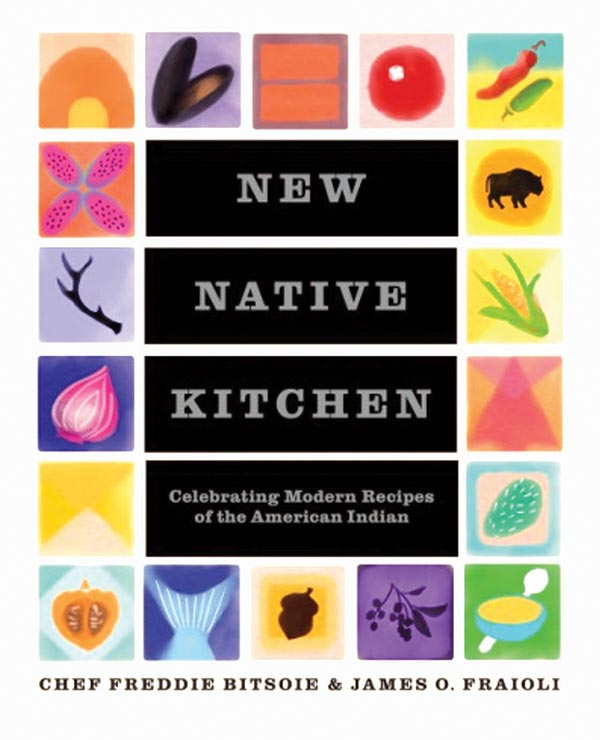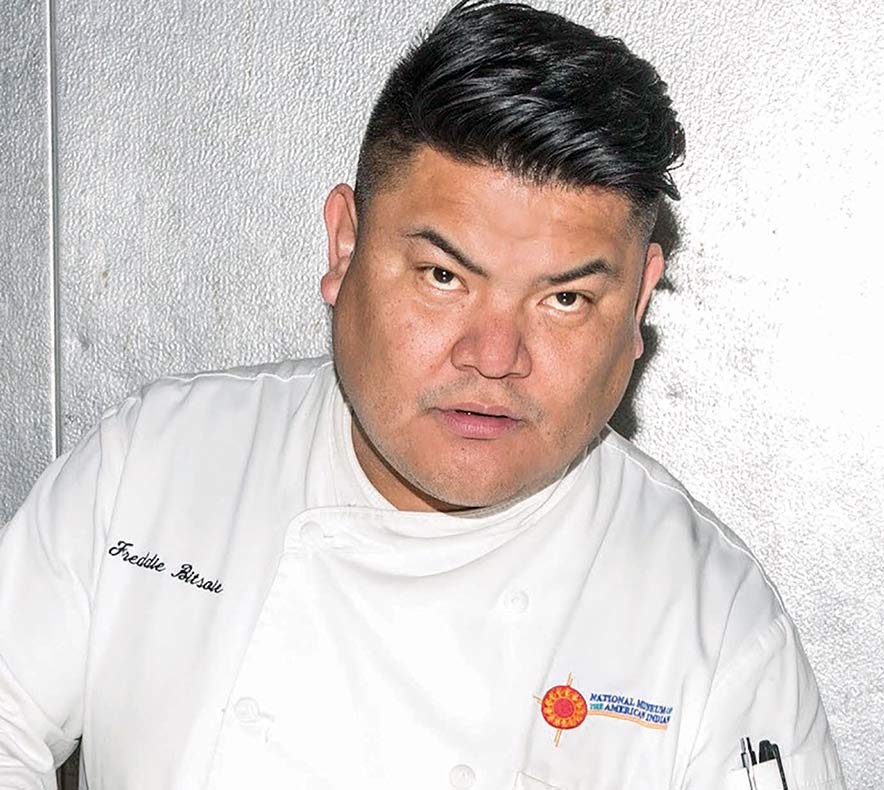
Keeping culture alive’: Diné chef pens contemporary Native cookbook
WINDOW ROCK
Acclaimed Diné chef and food educator Freddie Bitsoie says his new book, “New Native Kitchen,” coauthored with veteran food writer James Fraioli, celebrates Indigenous cuisine with a modern twist.

Courtesy photo
The cover of Freddie Bitsoie’s book, “New Native Kitchen: Celebrating Modern Recipes of the American Indian.”
“It’s a book about growth in Native American food,” Bitsoie said. “It’s really about how modern Native food can be.”
Bitsoie, who has traveled extensively to study the foods of tribes across North America, shares his expertise and culinary insights into Native American cooking and suggests new approaches for “every home cook.”
“These are traditional dishes,” he said. “It’s written in a modern sense, and I feel it doesn’t disrespect any cultural issues when it comes to the recipes. It’s just a new take on how these recipes can be presented.”
Bitsoie is a former executive chef of Mitsitam Native Foods Café at the Smithsonian’s National Museum of the American Indian. Bitsoie said when the Smithsonian closed due to COVID-19 in March of 2020, he knew it was time to refocus his energy on completing his cookbook, which includes 100 recipes he’s been working on for almost a decade.
“It’s a resource for people to have for when they want to dip their toe into Native cuisine,” he said. “It’s a way of highlighting these recipes that I’ve learned from my grandmother, people in my family, and elders across the country and interpreting them in a way that will appeal to people who are foodies and who like to eat.”
‘It’s about storytelling’
Bitsoie says what makes his book especially “rich with flavor” are the short anecdotes about each recipe about where each dish originated.
“They give a background of where I learned the recipe or where it comes from and how it became a part of my life,” Bitsoie said.
In fact, Bitsoie says the top commonality among Native American foods is that every recipe has a story, whether related to the dish’s historical, social, or familial roots.
“It’s very profound with Native foods,” he said. “It’s a teaching mechanism and keeping the culture alive. It’s really about the storytelling. I think it even mentally adds flavor to the dish.”

Courtesy photo | Mark Woodward
Diné Chef Freddie Bitsoie
“New Native Kitchen” includes traditional staples like Navajo mutton stew and Apache acorn soup and uses Bitsoie’s decades of experience in gourmet cooking to give the recipes his signature fine-dining take.
“The fundamental flavor and essence of the dish is there,” he said.
With recipes like pork chops with prickly pear barbeque sauce, chocolate bison chili, sumac-seared trout with onion and bacon, Bitsoie showcases the variety of flavor and culinary history offered from coast to coast in contemporary interpretations.
He says his cherrystone clam soup, pumpkin bread pudding with chocolate, and chicken and tomato stew, inspired by his Navajo grandmother, are some of his favorites that can be found in the book.
“My grandmother was one who could roast and bake in a wood-burning stove,” he said.
‘Culinary culture’
While Bitsoie now lives in Gallup, his father is originally from Birds Springs, Arizona, and his mother is from Aneth, Utah.
“I lived in every town on I-40 growing up, from Barstow to Albuquerque,” he said.
Bitsoie was always interested in cooking, but his college studies in anthropology inspired him to delve into the history of the “culinary culture” of Native peoples.
In his senior year at the University of New Mexico, he transferred to Le Cordon Bleu College of Culinary Arts in Scottsdale, Arizona, where he got the basic training that set him on his career path as a chef. The school closed in 2017.
“It was the best environment that I ever worked in,” he said. “I tell people it was the best eight dollars an hour I ever made in my life.”
He started creating recipes and developing a program to teach about Native foods, even if it was just for recreational cooking.
“That’s where it all started, and evolved from there and expanded my horizons,” he said.
Bitsoie started his own consulting business, FJ Bits, offering classes, public speaking engagements, and training for Indigenous cooks.
He helped develop menus at tribal casinos across the country, especially in the most rural areas, where it can be challenging to attract trained culinarians.
“It’s a really difficult thing to aspire to be a food star working in rural areas,” he said. “A lot of these casinos are beautiful, and they have great food outlets, but they don’t really have students who go to culinary school to come back.”
He has taught many aspiring Native cooks the fundamentals of restaurant cooking, including controlling food costs and making things taste better, he said.
“It was a niche that I was able to fulfill,” Bitsoie said. “I would research local Native foods and dive into a little bit of the history. Then we would make the recipes, which would be added to the casino menus.”
‘Fusion flair’
Bitsoie said that if restaurant patrons are spending money on fine dining dishes, there is an expectation that they have a “gourmet” or “fusion” flair.
“That’s the food business,” he said. “The beautiful thing about the Native American food market right now is all the different chefs have their own way of presenting it.”
Bitsoie says some of the main Native food staples prevalent among tribes are corn, beans, squash, deer, duck, turkey, salmon, lamb, quail, buffalo, and beef, readily available in grocery stores.
Agave nectar, prickly pear, cactus, sumac, rosemary, juniper, and sage are commonly used to add flavor to various dishes.
He enjoys combining traditional ingredients in innovative ways to create fusion recipes like cholla bud pesto and pureed sauce from Navajo dried corn for a new taste and texture.
However, Bitsoie says one of the difficult things with cooking Native foods is that specialty items like acorn flour, cholla buds, or agave, which must be freshly harvested locally, can be challenging to find and can be tremendously expensive.
“My job and that of other Native chefs is to make these more accessible,” he said. “It’s our job as food professionals to promote the ingredients to help lower the costs.”
In that vein, Bitsoie is working toward starting a Native foods warehouse and online store to expand that mission.
“I really do feel that everybody wants these ingredients,” he said. “They want these types of things in their pantry. It’s a growing business, and it’s only going to get bigger.”
New Native Kitchen, published by Harry N. Abrams, can be purchased from Amazon, Target, Barnes and Noble. To book speaking engagements, contact: Paul Zemitzsch, paul@exploregreen.com








 Highway 264,
Highway 264, I-40, WB @ Winslow
I-40, WB @ Winslow